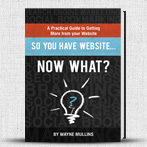9 Proven Strategies for More Website Traffic – Hint, this is #2
It’s a great feeling to simply send out an e-mail or to make a Facebook post and immediately start getting traffic to your website. Want to know what’s an even better feeling? Getting visitors to your site day after day without any new effort on your part. Here are the 5 Things You Need To Do In The First 3 Months Of A Campaign To Boost Traffic And Rankings.
There are certain strategies, like getting help from a digital marketing agency, that once implemented, will continually send you more website traffic. These aren’t some lofty or ridiculous ideas. No, all of these ideas are tried and true. And best of all, they work.
So let’s get going.
Strategy 1—Give Them a Reason to Return
Think for a minute about your favorite websites. You know, the ones that you go back to over and over again.
I’d be willing to bet that all of the sites you visit on a regular basis have one thing in common: fresh new content. Right?
You wouldn’t want to go to a website if it was the same thing over and over again. One of my favorites is Amazon. What I love most about Amazon is “discovering” new books that I haven’t read. In many cases, I find books I’ve never even heard of.
Amazon does this through a feature they call “Recommended for You.” If I’m looking at a new marketing book from Seth Godin, Amazon recommends additional books that may be of interest to me. Although the majority of the books they recommend for me have been out for a while, they are new to me. This web feature keeps me interested and engaged.
Now let’s talk about your website. What compelling reason are you giving prospects and clients to come back and visit your site again? If you can’t think of any, chances are pretty good that your website isn’t getting much repeat traffic. Let’s look at a few ways you can get visitors to come back.
Getting Repeat Visitors
If you want people to come back, you must provide them with a new experience each time they visit. Think Amazon. Their website design stays the same each time I visit (and has for years), but each time I’m on their website, it’s a completely unique experience. This is because of their recommendations.
So, how can you keep people coming back with a limited budget? Here are a few techniques:
- Rotate inventory—Move your inventory around the site. Change the inventory that is displayed on your home page.
- Rotate content—Move your content from page to page. Keep visitors wondering what will happen next.
- Release new inventory—Consider releasing new products or services regularly. Let visitors know when to expect new inventory.
- Release new content—A blog is a great way to release new content regularly.
- Allow user-generated content—Allow users to post reviews and comments. This will create a continual cycle of new content.
- Allow users to interact—Slides, videos, and audio are all great ways to make your website a multisensory experience.
- Interact with users—Let your visitors know you appreciate their attention and time. Give them tools to communicate directly to you.
- Entertain people—Make your website a fun place to visit.
- Don’t reveal everything—Let users “discover” things through your website. Don’t make all your content and inventory obvious.
- Invite participation—Let your visitors know you want them to participate in the content and conversation.
Strategy 2—Write Articles
Write articles to publish on other websites for free. Sound crazy? When I was first advised to write for free, I thought it was a ridiculous idea, but now I’ll be the first to highly recommend it. Here are three reasons why it’s important.
- Market penetration—Publishing articles on other websites allows you to spread your message to an audience that may not have heard about you or your message before.
- Backlink(s)—In exchange for having your article published on another website, you’ll typically receive a link(s) pointing back to your website. Backlinks are very important when it comes to Search Engine Optimization—which we’ll discuss in more detail shortly.
- Credibility—When you start referencing the sites to which you contribute, it helps build your credibility as an “expert” in your field.
Places to Publish Your Article
There are numerous places you can publish your articles online. All the places I recommend are completely free. Here are a few of those places:
- Squidoo.com
- Hubpages.com
- Ezinearticles.com
- Gather.com
- Goarticles.com
- Brighthub.com
- Buzzle.com
The disadvantage of publishing your work on article directories is that your article is only one of thousands that appear on the site. In many cases your article simply disappears into cyberspace.
Despite this flaw, there are still several reasons you should consider publish your articles on these directories.
Backlinks—The majority of the articles directories mentioned above give you the ability to add links pointing back to your website. It’s often said that links are the currency of the Internet, so this benefit alone can be extremely valuable. For a great SEO company, check out SEO Agency Sydney.
Credibility—In case you haven’t noticed, the Internet is the land of self-proclaimed “gurus.” The Internet has the Internet to claim to be an expert. Because of this guru trend, online users are becoming more and more skeptical. By publishing some of your articles on an articles directory, you can reference your published work on the directories to help demonstrate your “guru” status and build some credibility.
Better Than Article Directories
Article directories are great, but doing guest blog posts on other blogs can (and more than likely will) provide you with far more website traffic. Yes, guest blog posts are just what they sound like: publishing an article/post on another blogger’s website.
Let’s look at some of the benefits of guest blogging, and then we’ll go over very specific steps for getting other bloggers to allow you to do a guest post:
Instant credibility—To the blogger’s audience, you have instant credibility. It’s implied that if the blogger trusts you enough to be a guest author, then his or her audience should trust you as well.
Expanded reach—By publishing content on another person’s blog, you are exposing yourself and your message to an audience that you may not have otherwise reached.
Contextual authority—If you were to do a guest post here on this blog, my audience would automatically assume that you must be an authority in one of the core areas I write about on my blog. After all, why else would I allow someone who is not an authority to post on my blog?
Backlinks—Often bloggers will allow you to provide a backlink pointing back to your website. These links alone can prove to be a very valuable tool for generating traffic to your website.
Six Steps to Becoming a Guest Blogger
1. Build your previous work. I’ll be honest; this is the step most people don’t like to hear. Not because it’s difficult, but because it takes time. Before you begin reaching out to other bloggers, I recommend you spend at least three to six months building up your own content. This will give the blogger for whom you’re hoping to blog something to review to determine if you would be a good match for their audience. And it shows them that you aren’t a newbie.
2. Know their audience. I’m sure you’ve heard the ancient Greek saying, “Know Thyself.” Well, when it comes to being a guest blogger, you can throw it out the window and instead use “Know Them.”
When you are guest blogging, it is crucial that you know each blog’s audience. You need to know why they read that particular blog. You also need to know to what type(s) of blog posts they respond to the best. Here are a few ways to help you determine which posts the blog’s audience responds to most favorably:
- Number of comments
- Quality of the comments
- Number of shares on social media
- Number of times the blogger has published similar content
By taking some time to review the blogger’s past posts, you’ll be able to gain a pretty clear idea as to what his or her audience will like most.
3. Know their approach. Learning how they position themselves and how they approach their audience is easy to determine. Typically, you can figure this out simply by looking at their “About” page. Start by taking a look at what is there (the content) and how it is presented (the style):
- How are they attempting to position themselves?
- In what style is the page written?
Most bloggers position themselves in one of the following ways:
- Unapproachable expert
- Approachable expert
- Average guy just sharing his experiences
Without question, you can become a guest blogger for any of these types. However, the “approachable expert” will typically be the easiest avenue to take for getting a favorable response.
4. Casually ask the blogger. Bloggers—yes, even super successful bloggers—are just regular people. You shouldn’t be afraid to ask them to let you guest post, but you should do it in a casual way. Here’s an example:
======================
“Hi, John,
I hope you’re having a great week!
I’ve been following your blog for several months now, and I’m always amazed by the great content that you publish each week. I’m a marketing executive, so I particularly enjoy your posts on creative advertising techniques. Here are a couple of my favorite posts:
www.sample—blog.com/marketing—that—works
www.sample—blog.com/marketing—magic
I also blog over at www.myfakeblog.com on a variety of marketing topics. I know that you don’t publish many posts by guest authors, but I have a post that I really believe your readers may enjoy. It’s titled “30 Creative Marketing Techniques.”
I’ve attached a copy of the posts as well as the html version, should you decide to use it. You know your audience better than anyone, so feel free to edit the post however you see fit.
I’m sure you stay extremely busy, so I completely understand if you don’t have time to consider using my post.
Thanks again for all the great content you publish each week. Let me know if there is anything I can ever do to help you.
Best regards,
Wayne Mullins
=======================
You can see that this approach is very casual and unassuming. It gives the blogger an easy way out if he or she doesn’t like your post. If bloggers don’t respond, wait another week and send a very polite and casual reminder. If they still don’t, move on to the next opportunity.
5. Deliver as promised. Don’t be alarmed or offended if the blogger responds asking you to make edits or adjustments to your post. They know what their audience likes, so make the changes requested. Do it quickly. Don’t delay. If you tell them you’ll send back revisions within two hours, be sure you send back revisions within two hours. No later.
6. Show gratitude. Regardless, if the blogger accepts or declines your guest post, show them gratitude. If your post is accepted, you know what to say; but if your post is rejected, still let them know how much you appreciate and enjoy the content they publish. Let them know how you’ve specifically benefited from what you’ve learned on their blog.
It’s Going to Happen
You will be told no. And that’s completely normal—and okay. Don’t let this deter you. I’m not going to lie; getting your pitch to guest blog rejected isn’t easy to take. If you’re anything like me, this no will cause you to second guess your decision to guest post—and maybe even your decision to blog. Don’t lose heart, though. Instead, simply move on to the next person on your list.
While you’re reaching out and connecting with others, it’s a good idea to start thinking about the other opportunities that could arise from building relationships with these people.
Strategy 3—Online Networking
The web is really like one ginormous Chamber of Commerce networking event. It has never been easier to reach out and connect with others, but it’s also never been easier to ruin potentially rewarding relationships. The key to successful online networking is to take a strategic approach before connecting with online influencers.
Here are a few places and ways you can network on the web:
- a. Joint ventures—Find others with an audience similar to yours, but who don’t have directly competing products. Agree to promote their products or services in exchange for them promoting yours.
- b. Affiliate marketing—Affiliate marketing is similar to joint ventures, with the primary difference being that money is typically exchanged in return for a sale. (This is explored in a little more detail below.)
- c. Serve others—Don’t be the guy or gal who always has your hand out wanting something. Instead be the one who is always serving others in your online “community.” Before you ask someone for a favor, remember they are tuned in to WIIFM (What’s In It For Me).
Affiliate Marketing
There are several online affiliate marketplaces. These are places where you can find people looking to promote products as well as find products to promote. Clickbank.com is the largest and best website for finding digital products. Jounce.com is a great place for physical products.
One of the products I sell online is an e-book on how to start and grow a lawn business. I use Clickbank.com to find and manage my affiliates. When one of my affiliates sends someone to my website and they purchase my book, the affiliate is rewarded with a commission on that sale.
Strategy 4—Newsletter Publishing
This is my personal favorite strategy from getting more website traffic. A simple newsletter can keep current clients up-to-date on what’s happening as well as keep your name at the forefront of your prospect’s minds.
I actively used newsletters in a previous business. That business experienced at 300 percent growth rate for three consecutive years. We actively use newsletters at Ugly Mug Marketing, and we have experienced a very similar growth rate.
Here are a few things to consider including in your newsletter:
- a. Actionable advice—Provide some specific, relevant advice that your clients can immediately implement.
- b. Data—Give sales data, number of clients, working projects, and anything else that helps build your credibility.
- c. Call to action—Your newsletter needs to have a clear call to action. Tell the readers exactly what they should do next and why they’ll benefit from doing it.
- d. Testimonials—There’s no better way to build credibility. Have people talk about what they experienced from working with you and your business.
- e. Client profiles—Consider featuring one of your “best” clients in your newsletter. This provides a lot of goodwill between you and your client, and it provides a great way to “borrow” your client’s credibility.
There are many services online that provide easy-to-build online newsletter templates. My personal favorite is Aweber.
Strategy 5—Get Links, a.k.a. Backlinks
Work on getting other websites to link to your website. We cover more about getting links this post.
Strategy 6—Foster Referrals and Sharing
Both can be summed up in the phrase “word of mouth.” Look at your site through the eyes of a visitor, and then ask yourself, “Is there anything here that I would want to share with my friends?” If not, what could you add that would be worthy of sharing with others?
Here are some ideas:
- a. Reward referrals —Give your visitors an incentive for referring others. You may be able to offer a special discount or access to a member’s only area for visitors whom refer others to your website.
- b. Make it easy—Make it easy for others to share on Facebook and Twitter. If you’re using WordPress, take a look at adding the Sharebar and Share This plugins.
- c. Let them know—Getting your visitors to share and refer others may be as easy as letting your visitors know you expect them to share or refer, and that doing this is normal on your website.
Strategy 7—Search Engine Optimization
Way too much to cover here. You can learn more here.
You can also find out how to start a Freelance SEO career.
Strategy 8—Video
YouTube.com is now the second-largest search engine on the web (behind Google). Video is quickly becoming the most consumed form of media on the web. It’s now easier than ever for businesses to utilize video to generate online traffic.
Brian Goulet is a master of using video to drive traffic and ultimately sales to his website. I was first introduced to Brian after doing a search for a Moleskine journal review. I stumbled across a comparison video (http://youtu.be/LqCCyNMW7do) in which he was examining a Moleskine journal and a Rhodia journal.
That one simple video led me to purchase my first Rhodia journal from Goulet Pens; and because of Brian’s exceptional marketing, I’ve since ordered over a half-dozen times from him.
When considering video, most people become paralyzed with fear. They don’t know what to say. They don’t know what to do. They don’t know how to edit. The list grows with excuses. Brian had many of those same fears when he began using video, but he didn’t let those fears prevent him from taking action.
Here are a few resources:
- a. Camera—You can obtain a good-quality HD camera for less than two hundred dollars. Here are a couple of my favorites:
- i. Flip UltraHD—you can get it on Amazon.com for about $130.
- ii. Kodak Zi8—you can get it on Amazon.com for less than $150.
- b. Where to share—There are a lot of places online you can share your video. Here are some of the most popular:
i. Youtube.com
ii. Google.com/Video
iii. Vimeo.com
iv. Viddler.com
v. Facebook.com
Strategy 9—Better Design
If you tell me you provide high-quality products or services, yet your website looks like it was built in 1995, I will question your claim about high-quality products or services.
Conclusion
Again, I can’t stress enough the importance of getting started. Pick any one of the strategies above and begin working on it. I realize you may still have many unanswered questions, but please don’t let that stop you from taking action. With action you’ll never start getting more website traffic. You can learn and get answers along the way, but the key to success is in taking action—daily.
- Likes, Shares, & Comments WON'T Put Money In Your Bank Account.
- In Our Free Course: Crush It On Facebook In 30-Days Or Less
- You'll Discover: A Simple Facebook Strategy We Used To Take a Client From Losing $10k Each Month To Making Thousands...In Only 86 Days.
- The 3-Step Formula We Used To Increase Another Client's Sales By Over $9,000 per Month (and they're spending less than $400 per month on Facebook Ads)




One thought on “9 Proven Strategies for More Website Traffic – Hint, this is #2”